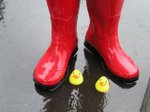 I don't know what to do with Heidi Julavits' The Uses of Enchantment. I mean, what a strange book. I've not read Julavits' two previous novels, but the customer reviews I've read for them usually mention general weirdness and Julavits biting off more than she can chew. I get the sense that Julavits is chewing better now, but still, it's quite a mouthful (this metaphor ends here, I say).
I don't know what to do with Heidi Julavits' The Uses of Enchantment. I mean, what a strange book. I've not read Julavits' two previous novels, but the customer reviews I've read for them usually mention general weirdness and Julavits biting off more than she can chew. I get the sense that Julavits is chewing better now, but still, it's quite a mouthful (this metaphor ends here, I say). So, we've got the mysterious disappearence of a teenager, all right. Whose mysterious disappearence is repetitious of another teenager's disappearence ten years before. Both girls obsessed with a seventeenth century story of a girl abducted by Indians, whose rescuer was subsequently hanged as a witch. And the first girl is apparently descended from a Salem witch. And she returns home fifteen years later after her mother's funeral, in order to resolve what happened to her. And most of the narrative is played out through the rivalry of two psychotherapists with opposing missions. Incredibly intertextual, though the only text I was familar with was Dora. And that's about it, I think. All in one book. It really doesn't make sense until you read it.
And so I'm mystified, but I still enjoyed this book. There is a race to the end, and I think Julavits' climax is worthy of the suspense she creates, and I found the ending satisfying. The main character (the derivatively disappeared girl, Mary Veal) is impossible to pin down, though this is created more by Julavits narrative than what the characters says or does. In fact, sometimes too much explanation is given and I wished the story had remained a bit more "enchanted". Which is the problem. Julavits introduces so many fascinating avenues in her story, that of course many remain insufficiently explored. This isn't completely annoying, because on a whole this book manages to function (I have no idea how though).
My confusion is somewhat akin to enchantment though. Whatever Heidi Julavits did, she did it right. I also like how when you remove the dust jacket of this book, in gold script on the black cover it simply says, "A Novel". Indeed it is. Sort of.

